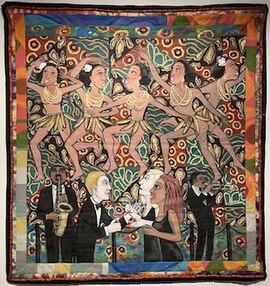Descriptions and locations
Each quilt is made with acrylic paint on canvas, bordered by patterned fabric; they do not contain written text like the previous quilt series. The quilts continue the story of Willia Marie Simone and her descendants that Ringgold began in The French Collection. The American Collection focuses on Willia Marie's daughter Marlena who, after being raised by her mother's Aunt Melissa in Harlem while her mother was living as an artist in Europe, becomes an artist herself. Ringgold's daughter described the conceit of the series:
The American Collection was intended to be composed of twelve pieces, one of which was never completed and all of which were to be understood as paintings done by Marlena, Willia Marie's adult daughter, as a successful Black woman artist living in the United States. She should be regarded as a doppel-ganger for Faith, living and working in roughly the same time frame but more successful, possibly because she has no husband and children.
—
Michele Wallace, "Dancing at the Louvre", Faith Ringgold: American People (2022)
Five quilts are now located in public collections across the United States, and six remain in private collections.
#1: We Came to America
We Came to America depicts the Statue of Liberty as a Black woman holding a small child, surrounded in the water by escaped formerly enslaved people. The flame on the statue's torch has been mostly extinguished. The people in the water are flailing and screaming while a slave ship burns far in the background. Ringgold's daughter has noted that the Statue of Liberty was not constructed until several decades after the Civil War and nearly a century after the end of legal importation of enslaved people, meaning this scene contains not only an alternate version of the statue, but also an alternate version of history.
We Came to America is in the collection of the Pennsylvania Academy of the Fine Arts, Philadelphia. [6]
#2: A Family Portrait
A Family Portrait depicts Aunt Melissa with Marlena standing at her feet and Marlena's brother Pierrot sitting on her lap. Willia Marie and her French husband are depicted in paintings on the wall behind the family. Nearly every member of the family has a different skin tone, as the family is multiracial.
As of 2022, A Family Portrait was in the private collection of economist William Landes and Elisabeth M. Landes.
#3: Born on a Cotton Field
Born on a Cotton Field depicts an enslaved man and woman cradling a baby in a cotton field while a massive surreal Black male figure stands above them with impossibly long arms wrapping around the family. Over two dozen faces of other enslaved people are partly visible, hidden amongst the cotton in the field. Ringgold later used this scene in her children's book The Invisible Princess (1999).
As of 2022, Born on a Cotton Field was in a private collection.
#4: Jo Baker's Bananas
Jo Baker's Bananas depicts Marlena and her brother Pierrot standing in front of Marlena's painting of the American-born French performer Josephine Baker. Baker is depicted in five different dance poses, wearing her signature stage outfit of no clothes apart from a skirt made of bananas and a layered necklace. The scene takes place at the Museum of Modern Art for an opening of an exhibition of Marlena's paintings. Two jazz musicians are pictured performing at the opening.
Jo Baker's Bananas is in the collection of the National Museum of Women in the Arts, Washington, D.C. [7]
#5: Bessie's Blues
Bessie's Blues depicts the face of blues singer Bessie Smith repeated 20 times in a square grid, rendered with a deep blue skin and with features and hair of varying shades of orange, peach, and yellow. Smith appears to be singing in the images, which are arranged and colored in the style of Andy Warhol's signature repetitive portraits like Marilyn Diptych (1962).
Bessie's Blues is in the collection of the Art Institute of Chicago. [8]
#6: The Flag is Bleeding #2
The Flag is Bleeding #2 depicts three figures standing within the confines of a bloody American flag. A Black woman stands in the left of the flag with several bleeding wounds on her chest and tears of blood streaming from her eyes. She is embracing her two young children who stand naked at her feet, hugging her legs over her dress. Ringgold was inspired by her earlier painting The American People Series #18: The Flag is Bleeding (1967), which similarly depicts a group of people standing inside a bloody flag, but did not include any Black women.
The Flag is Bleeding #2 is in the collection of Glenstone, Potomac, Maryland. [9]
#7: Stompin at the Savoy (unfinished)
Ringgold sketched several compositions for Stompin at the Savoy but ultimately did not complete the quilt.
#8: Cotton Fields, Sunflowers, Blackbirds and Quilting Bees
Cotton Fields, Sunflowers, Blackbirds, and Quilting Bees depicts a group of Black women sitting in a field full of cotton plants and sunflowers with several flocks of black birds flying in the distance. The figures are quilting together, creating a large checkerboard pattern quilt with dozens of sunflowers. This quilt is a direct reinterpretation of Ringgold's earlier quilt Sunflowers Quilting Bee at Arles (1991), from The French Collection. Ringgold's daughter has referred to it as a "replacement" for the earlier quilt, which was purchased by Oprah Winfrey.
As of 2022, Cotton Fields, Sunflowers, Blackbirds and Quilting Bees was in a private collection.
#9: The Two Jemimas
The Two Jemimas depicts two Black women standing side by side, rendered with grotesquely over-sized proportions and features. The figures are wearing embroidered orange dresses and pearls, with skin ranging from deep blue to grayish black. The two women are meant to be portraits of the blackface minstrel show character and longtime pancake syrup brand mascot Aunt Jemima. Ringgold drew inspiration for the figures from Willem de Kooning's style of painting female figures, in particular his Woman and Two Women series.
The Two Jemimas is in the collection of Glenstone, Potomac, Maryland. [9]
#10: Wanted: Douglass, Tubman, and Truth
Wanted depicts the abolitionists and activists Frederick Douglass, Harriet Tubman, and Sojourner Truth standing together in a verdant forest. Ringgold was inspired to create the work after wondering whether the three figures had met one another.
As of 2022, Wanted: Douglass, Tubman, and Truth was in a private collection.
#11: Picnic on the Grass Alone
Picnic on the Grass Alone depicts Marlena sitting alone at a picnic in the forest, having been stood up by a man for a date.
As of 2022, Picnic on the Grass Alone was in the private collection of investment manager Eddie C. Brown and C. Sylvia Brown.
#12: Listen to the Trees
Listen to the Trees, like Picnic on the Grass Alone, depicts Marlena alone in the forest. She is holding a bouquet of wildflowers and looking toward a stream surrounded by dense foliage. Ringgold's daughter has written that Marlena, unlike her mother Willia Marie, is depicted as financially successful but ultimately single and without children, reflecting the artist's ongoing meditations on the impact having children has on the career of women artists.
As of 2022, Listen to the Trees was in a private collection.

African-American art is a broad term describing visual art created by African Americans. The range of art they have created, and are continuing to create, over more than two centuries is as varied as the artists themselves. Some have drawn on cultural traditions in Africa, and other parts of the world where the Black diaspora is found, for inspiration. Others have found inspiration in traditional African-American plastic art forms, including basket weaving, pottery, quilting, woodcarving and painting, all of which are sometimes classified as "handicrafts" or "folk art".

Faith Ringgold was an American painter, author, mixed media sculptor, performance artist, and intersectional activist, perhaps best known for her narrative quilts.
Michele Faith Wallace is a black feminist author, cultural critic, and daughter of artist Faith Ringgold. She is best known for her 1979 book Black Macho and the Myth of the Superwoman. Wallace's writings on literature, art, film, and popular culture have been widely published and have made her a leader of African-American intellectuals. She is a Professor of English at the City College of New York and the Graduate Center of the City University of New York (CUNY).

Clementine Hunter was a self-taught Black folk artist from the Cane River region of Louisiana, who lived and worked on Melrose Plantation.
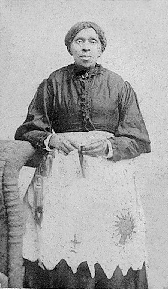
Harriet Powers was an American folk artist and quilter born into slavery in rural northeast Georgia. Powers used traditional appliqué techniques to make quilts that expressed local legends, Bible stories, and astronomical events. Powers married young and had a large family. After the American Civil War and emancipation, she and her husband became landowners by the 1880s, but lost their land due to financial problems.
Kerry James Marshall is an American artist and professor, known for his paintings of Black figures. He previously taught painting at the School of Art and Design at the University of Illinois at Chicago. In 2017, Marshall was included on the annual Time 100 list of the most influential people in the world. He was born and raised in Birmingham, Alabama, and moved in childhood to South Central Los Angeles. He has spent much of his career in Chicago, Illinois.

Dindga McCannon is an African-American artist, fiber artist, muralist, teacher, author, and illustrator. She co-founded the collective Where We At, Black Women Artists in 1971.

Tar Beach, written and illustrated by Faith Ringgold, is a children's picture book published by Crown Publishers, Inc., 1991. Tar Beach, Ringgold's first book, was a Caldecott Honor Book for 1992.
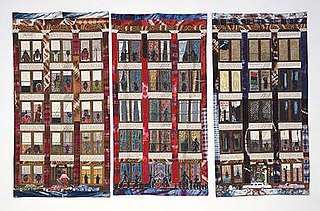
Street Story Quilt is a 1985 painting by Faith Ringgold. It is in the collection of the Metropolitan Museum of Art in New York City. It is one of many pieces in a body of work of story quilts created by Ringgold.
Cecelia Tapplette Pedescleaux, also known as Cely, is an African-American quilter of traditional and art quilts, inspired by historians, other African-American quilters, and quilt designs used during the Underground Railroad to communicate messages to slaves seeking freedom. Her quilts have been shown in China, France, Washington, D.C., New Orleans, and in other locations in the United States. A solo show of 75 of her quilts were shown at the Le Musée de Free People of Color in New Orleans (2013–2014).
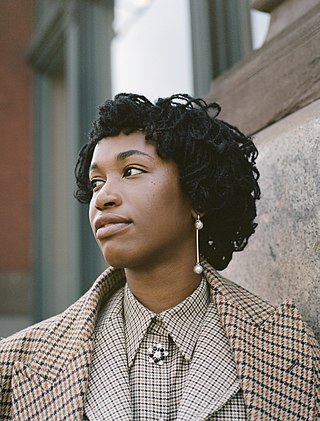
Tschabalala Self is an American artist best known for her depictions of Black female figures using paint, fabric, and discarded pieces of her previous works. Though she uses mixed media, all of her works are on canvas and employ a "painting language." Inspired by works done by African-American artist Romare Bearden, Self creates collages of various items that she has collected over time and sews them together to depict Black female bodies that "defy the narrow spaces in which they are forced to exist". She derives the concept from the history behind the African-American struggle and oppression in society. Self reclaims the Black female body and portrays them to be free of stereotypes without having to fear being punished. Her goal is to "create alternative narratives around the Black body." Much of Self's work uses elements from Black culture to construct quilt-like portraits. Self lives in Hudson, New York.

Lisa Farrington is an American art historian, specializing in African-American art, Haitian art, and women's art. She is a Distinguished Professor in the Department of Art and Music at the John Jay College of Criminal Justice. Farrington is one of the major scholars of Faith Ringgold, is the author of several books on African-American art, and is one of only six full professors of African-American art history in the United States.
Bisa Butler is an American fiber artist who has created a new genre of quilting that has transformed the medium. Although quilting has long been considered a craft, her interdisciplinary methods—which create quilts that look like paintings—have catapulted quilting into the field of fine art. She is known for her vibrant, quilted portraits celebrating Black life, portraying both everyday people and notable historical figures. Her works now count among the permanent collections at the Smithsonian National Museum of African American History and Culture, the Art Institute of Chicago, Pérez Art Museum Miami and about a dozen other art museums nationwide. She has also exhibited at the Smithsonian Museum of American History, the Epcot Center, the National Underground Railroad Freedom Center, and many other venues. In 2020, she was commissioned to quilt cover images for Time magazine, including the "Person of the Year" issue and its "100 Women of the Year" issue. With a multi-year wait list for private commissions, one of Butler's quilts sold at auction in 2021 for $75,000 USD.
Sue Willie Seltzer (1922–2010) was an American artist. She is associated with the Gee's Bend quilting collective. Her work has been exhibited at the Museum of Fine Arts, Houston and the National Gallery of Art, and is included in the collection of the New York Metropolitan Museum of Art and the Philadelphia Museum of Art.
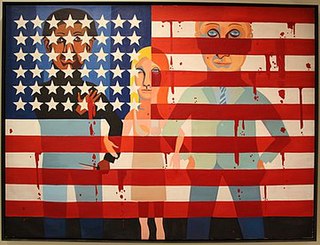
The American People Series #18: The Flag is Bleeding is an oil on canvas painting made by American artist Faith Ringgold in 1967. Widely cited as one of Ringgold's most iconic and pivotal works, the painting depicts a Black man, white woman, and white man interlocking arms inside the confines of an American flag dripping with blood, some of which is seemingly from a wound on the Black man's chest. The Flag is Bleeding was painted toward the end of the American Civil Rights movement and explores themes of race, gender, and patriotism.

The American People Series #20: Die is an oil on canvas painting made by American artist Faith Ringgold in 1967. Inspired by Pablo Picasso's painting Guernica (1937) and painted amidst the riots and uprisings of the 1960s, Die is a two-panel work depicting a group of Black and white men, women, and children, most of whom are wounded or covered in blood, variously fighting, fleeing, or dying against an abstract grey background. The piece has been extensively cited as among Ringgold's most important and iconic artworks.
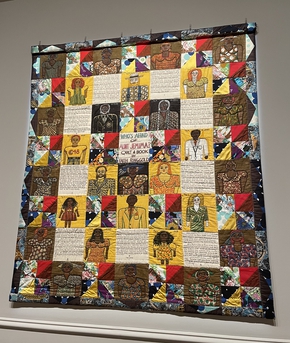
Who's Afraid of Aunt Jemima? is an acrylic on canvas narrative quilt made by American artist Faith Ringgold in 1983. Named for the Edward Albee play Who's Afraid of Virginia Woolf? and the character Aunt Jemima, the work is Ringgold's first story quilt and marks the early stages of the artist's shift from oil painting to quilting.

The French Collection is a series of twelve quilt paintings by American artist Faith Ringgold completed between 1991 and 1997. Divided into two parts composed of eight and four quilts each, the series utilizes Ringgold's distinct style of story quilts to tell the fictional story of a young African American woman in the 1920s, Willia Marie Simone, who leaves Harlem for Paris to live as an artist and model. The stories, illustrated in acrylic paint and written in ink surrounding the paintings, narrate Willia Marie's journey as she befriends famous artists, performers, writers, and activists, runs a café and works as a painter, and develops a distinct Black feminist intellectual worldview based on her experiences and identity. Willia Marie's interactions with notable modernist artists and their oeuvres are an archetypical example of Ringgold's responses to the predominantly white male artistic canon, wherein she often directly invoked, embraced, and challenged the central figures of modernist art.
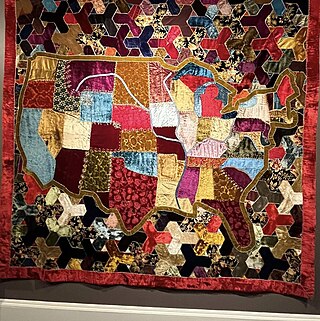
Narrative quilting describes the use of blanket weaving and quilting to portray a message or tell a story. It was a means of sending messages and recording history for women that were unable to participate in politics throughout time.
